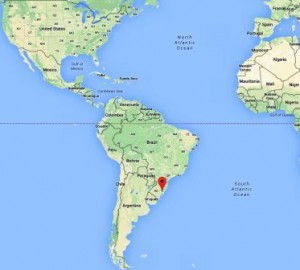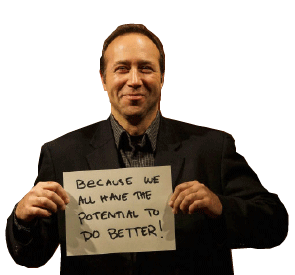Conventional thinking says showing up is half (or 80%) of being successful. This is rubbish. If you just show up, you’ll not like the results. Even if you do, others will not. Showing up isn’t good enough for things that matter. Imagine a news anchor “just showing up” or a keynote speaker, actor, executive, job applicant, bride or groom, sales executive, or you. Showing up might be okay for insignificant things like cleaning your garage or drinking coffee in your pajamas while reviewing pre-breakfast social media trends. But, most of us aim for bigger moments in life. And in those moments we’ll want to do more than show up. Here is some secret sauce to make the most of moments that should matter.
Think of Big Moments as Events
No matter what you are working on it can be represented as an event that completes at a point in time. The exception to this is a program. Programs by definition are ongoing as opposed to projects which are finite in duration. Programs can be thought of as a series of connected projects.
The Point in Time
If you are working on planning an event the point in time becomes obvious. It’s the moment that eventually arrives. After all, you’ve put it on the calendar and probably invited people. But, less obvious are things like product launches, website launches, design of new services, communications, strategic planning, assembling a team, creating a movie, going on vacation, or moving to a new location.
The Big Moment
So, we have this point in time where your, we’ll call it “big moment”, completes. Let’s unpack that moment. There is the time leading up to your big moment as well as the time that follows. And of course your big moment covers a span of time as well. For an event that might be an hour or a few days in the case of a trade show event. So, really we have three periods of time, or time zones.
Thinking in Three Zones
As it turns out, anything you’re working on has these three zones. If you are mindful of the preparation leading up to the big moment then no doubt when your big moment arrives it will be smoother, higher quality, more engaging, and more likely to yield the results you want. And, when that happens the zone following your big moment will be likely involve sharing, celebration, reflection, and more opportunity.
Ignorance is not Bliss
But, ignore any of the time zones and you are leaving much to chance. Imagine the best trade show ever (or family reunion). Of course you’d love to have pictures to relive the memory of where you connected with your best customer (or cherish the memory of when your favorite Aunt was still alive). Well, to have those pictures to reflect upon, somebody somewhere would have had to think to secure a photographer or provide instructions to many people to take pictures and later share. Without that forethought, the event would unfold in time and the opportunity to take pictures will evaporate along the way. Time marches on whether you are prepared for it, or not.
Make the Most of Your Big Moments
To make the most of your big moments, whether you are working alone or alongside a team, think in three time zones. What needs to happen ahead of the event, during the event, and following the event.
Zone I – Readiness
Most things of any significance cannot be accomplished alone. Things to think about in the readiness zone include:
- Who needs to be prepared?
- What information will be needed? How will we get it?
- What is the sequence of actions leading up to the moment?
- What can be completed ahead of time?
- What communications need to be created?
- What deadlines to we need to be aware of?
- Who can help accomplish all of this?
Zone 2 – The Moment
Project yourself ahead in time to the big moment and answer the following questions:
- Who is the intended audience and what will be their context?
- What experience do we need to create for them? (See CH 1: What is an Experience?)
- What will ensure the experience unfolds as planned?
- Should we aim for remarkable, unbroken, or generous? (See CH 6: Aiming for Remarkable, Unbroken, and Generous Design)
- Who will be on point for different activities?
- Will we capture the moment in pictures, sound, or some other medium?
- Who will keep us orchestrated?
- What could go wrong and how will we mitigate?
Zone 3 – The Follow
After the big moment completes there is the tendency to rush to the next thing. But, here is a case where slowing down now can actually help you to speed up later. Follow-up, debrief, and apply what you just learned so that you can positively impact what’s next. Some of the things to think about here include:
- What should be the follow-up with our audience(s)?
- What did we learn and how will we apply it?
- Who can benefit by our sharing?
- Did we or can we still gain validation?
- How could this event be even better next time?
- Was it worth it? Shall we repeat it?
- What should we adjust going forward?
Summary
If you want to make your big moments matter then you’ll need to imagine yourself in each of three zones before they actually unfold in time. Thinking about what will need to happen in each zone and having conversations with others who will be involved will make the difference between an memorable event that makes a big impact and a lackluster event where people simply showed up. A couple of other guiding principles to keep in mind are:
- A task unclaimed is a task undone;
- Inspiration has expiration so best to get started soon;
- Show visible progress to keep motivated and moving forward;
- Checklists are good insurance against overconfidence
If you are working in a team then introduce the three time zones into your business vernacular. Those big moments that await you will notice the difference along with your audience and the team that played a part in making it all happen.
about the author
Gregory Olson authored The Experience Design Blueprint, a book about designing better experiences and then making them come true. Chapters in the book that especially pertain to this article include:
- Chapter 2: Make the Customer Come Alive
- Chapter 6: Aiming for Remarkable, Unbroken, and Generous Design
- Chapter 8: The Promise Delivery System
- Chapter 11: Barriers to Innovation and Overcoming the Wall
- Chapter 13: Taking Flight
Gregory Olson’s latest book is L’ impossi preneurs: A Hopeful Journey Through Tomorrow, a light-hearted and deadly serious book about a brighter future where we live more meaningful lives, governments invest in people and sustainable progress, and technology serves humans.
 Gregory Olson founded strategy and design firm Delightability, LLC. with the belief that if you delight customers then success will follow. He believes that we all have the potential to do better, as individuals, organizations, and communities, but sometimes we need a little help. Gregory also serves as a volunteer board member for Oikocredit Northwest, a support association for social and impact investor,Oikocredit International.
Gregory Olson founded strategy and design firm Delightability, LLC. with the belief that if you delight customers then success will follow. He believes that we all have the potential to do better, as individuals, organizations, and communities, but sometimes we need a little help. Gregory also serves as a volunteer board member for Oikocredit Northwest, a support association for social and impact investor,Oikocredit International.




 Gregory Olson founded strategy and design firm Delightability, LLC. with the belief that if you delight customers then success will follow. He believes that we all have the potential to do better, as individuals, organizations, and communities, but sometimes we need a little help. Gregory also serves as a volunteer board member for
Gregory Olson founded strategy and design firm Delightability, LLC. with the belief that if you delight customers then success will follow. He believes that we all have the potential to do better, as individuals, organizations, and communities, but sometimes we need a little help. Gregory also serves as a volunteer board member for 











 Gregory Olson founded strategy and design firm Delightability, LLC. with the belief that if you delight customers then success will follow. He believes that we all have the potential to do better, as individuals, organizations, and communities, but sometimes we need a little help. Gregory also serves as a volunteer board member for
Gregory Olson founded strategy and design firm Delightability, LLC. with the belief that if you delight customers then success will follow. He believes that we all have the potential to do better, as individuals, organizations, and communities, but sometimes we need a little help. Gregory also serves as a volunteer board member for 







